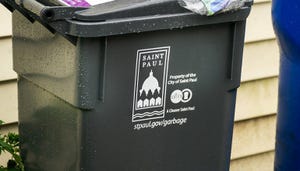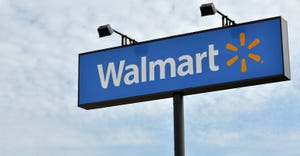Mixed Waste Recycling in New York Too Costly
February 1, 2001
Patricia-Anne Tom
During the past decade, mixed waste processing has been proposed periodically as one way to improve recycling diversion rates in low-rate collection districts. However, New York City is not likely to use mixed waste processing of recyclables, based on a recently released analysis of a December 1997 Department of Sanitation pilot study.
According to the analysis, raising diversion rates by extracting recyclables from waste loads in low-diversion districts were estimated to have a net incremental cost of as much as $90 per ton to $200 per ton, and would require sorting facilities, which are unavailable locally.
New York currently is striving to meet its 25 percent recycling mandate. But in mid-1997, the city's 20 lowest-diversion districts only were recycling at 8 percent. The other 39 districts had an 18.7 percent rate, with a citywide average of 14.4 percent. Since then, expansions of designated material, weekly collection and ongoing public advertising have raised diversion rates. By the end of the city's fiscal year 2000, the average was 15 percent for the 20 districts and 21 percent citywide.
Consequently, the city needed to develop options to raise its recycling rate to meet the 25 percent mandate. Six scenarios were considered, but the only one that appeared to save money while increasing recycling required collecting waste and recyclables together for processing within the city.
"Transportation costs are such a big part of total costs that it isn't surprising that collecting blue, clear and black bags on the same truck could save money under some conditions," says Robert Lange, director of the Department of Sanitation's Bureau of Waste Prevention, Reuse and Recycling. However, the city wasn't sure if mixed waste processing would discourage source-separation of recyclables.
As a result, the city decided to test the viability of a mixed waste recycling program.
Before the pilot could be implemented, however, New York needed to determine the waste composition and amount that could potentially be recycled. Twenty waste collection routes were selected randomly from targeted districts to create recyclables composition baselines. For one week, samples of approximately 2,000 pounds to 3,000 pounds were taken from each route, and standardized to a pounds per household per day basis for comparison. Paper, metal, glass and plastic were collected in the same vehicle; normally they are collected separately.
Based on recyclables being sorted one time from all of the set-outs, the city determined the actual recyclables composition was 23.2 percent: Approximately one-third of the 23.2 percent was found in the recycling set-outs, the rest was placed in the waste. This reflects a measured capture rate of 32.2 percent.
After taking into account glass residuals not sorted under the study's protocols and the differences in paper definitions, the recyclables composition rate was adjusted to 30.2 percent. This was less than a 1990 composition rate of 43.4 percent for comparable districts.
New York also discovered that the differences in recyclable composition came from paper and to a lesser extent metal and glass. The recycling composition rate for paper was 20.6 percent in 1997, significantly less than the 28.4 percent found in 1990.
According to the city, many factors could have contributed to the rate differences, including study design, objectives, protocols, one-time testing and general change in waste composition. Given less paper in the waste stream, low-income collection districts also seemed to be doing a better job of recycling than had been assumed. And the city concluded that it might have greater difficulty than originally anticipated in achieving the 25 percent diversion rate.
If the new recyclables composition rate represented all low-diversion districts, the rest of the city would have to achieve a capture rate of 87.7 percent, Lange said. This would equal a citywide average capture rate of 75.6 percent to reach 25 percent diversion.
Nevertheless, New York City proceeded with the mixed waste-processing pilot. The city sorted co-collected waste and recyclables for one week in one district and composted a portion of the organic residual. It recognized that the results would reflect some trade-off between transportation savings and material quality.
Source-separated recyclables were collected on the district's normal recycling collection days along with waste. The material collected - waste, and waste with recyclables - went through a sorting line at a privately owned facility in Brooklyn, N.Y. Some of the sorted products were processed further so they could be marketed at a second facility, modeling a two-stage single processing facility.
In total, 665.3 tons of waste and recyclables were delivered to the Brooklyn sorting facility. The portion of the residue that passed through a 4-inch screen was used for a composting test. The facility also recovered a "fiber pack" of all recyclable paper types, as well as a commingled fraction, called MGP, comprised primarily of mixed plastic and some glass containers. Most of the metal was separated using magnets and recovered for marketing. Clean wood was recovered through hand-sorting. Wood and ferrous material were marketed from the Brooklyn facility. The recovered fiber and MGP were shipped in bulk containers to the second facility for additional processing.
The total recovered marketable product from waste-only loads was 11.4 percent; the total from waste and co-collected recyclables was 16 percent. These rates were net of residue and provided the basis for describing two program rates.
Based on the pilot, the first rate suggested that the city could increase a given recycling diversion rate by 11.4 percentage points if waste was sorted in a mixed waste processing facility and as much as two-thirds of recyclables were recovered from improperly sorted household waste. In a district with an 11.1 percent diversion rate, the added processing would raise the rate to 22.5 percent. However, this rate combines post-sorting tests results - net residue - with monthly measurements from presorted waste - gross residue.
With recyclables and waste processed together, the pilot suggested a 16 percent net diversion rate, based on the portion of material actually marketed. If household source-separation continued and items were processed through a mixed waste facility, the 16 percent net diversion rate would be more than the curbside program's 11.1 percent but lower than the 18.7 percent of separate collection and recyclables and wastes processing.
With this data, the city then had to determine the costs of waste processing in addition to the existing recycling program vs. co-collecting and processing waste and recyclables. An engineering consultant determined capital and operations and maintenance (O&M) costs based on conceptual facility designs of different sizes and locations. The processing test rates were assumed to be typical of all low-diversion districts. Transportation cost estimates were based on a departmental model.
The city developed six models to evaluate the net effects of:
- Economies of scale offered by a single larger plant;
- Lower transportation costs using two smaller plants;
- Additional lower transportation costs under combined collection of waste and recyclables; and
- Higher diversion rates under separate collection of waste and recyclables.
The evaluation measured incremental cost, which is defined as a change in cost of the city's waste management system when adding or deleting a specific program. Direct and avoided costs were measured.
For the first three cases, diverting additional recyclables from waste recovered in mixed waste processing became an incremental cost. Savings were realized from not having to dispose of this amount.
For the last three cases, incremental costs included processing materials together. Savings involved the avoided costs of additional collection routes and of alternate disposal. Low- and high-cost assumptions were made for interest rates and disposal costs.
During most of the processing scenarios and economic assumptions, mixed waste processing showed significant cost or negligible savings per additional ton of recyclables recovered. Revenue offsets from secondary materials were relatively small compared to other costs, particularly facility and transportation costs. The only scenario that showed measurable savings required low-cost assumptions and two in-city processing locations.
Based on its pilot and cost estimates, New York City determined that mixed waste processing was not a program option in the foreseeable future.
Additionally, Lange noted, if co-collection actually were instituted, observation would be necessary to determine whether residents would become less careful about source-separation and thus, reduce the material quality. If quality decreased, it would likely reduce diversion rates and remove any saving advantages from co-collection.
You May Also Like


